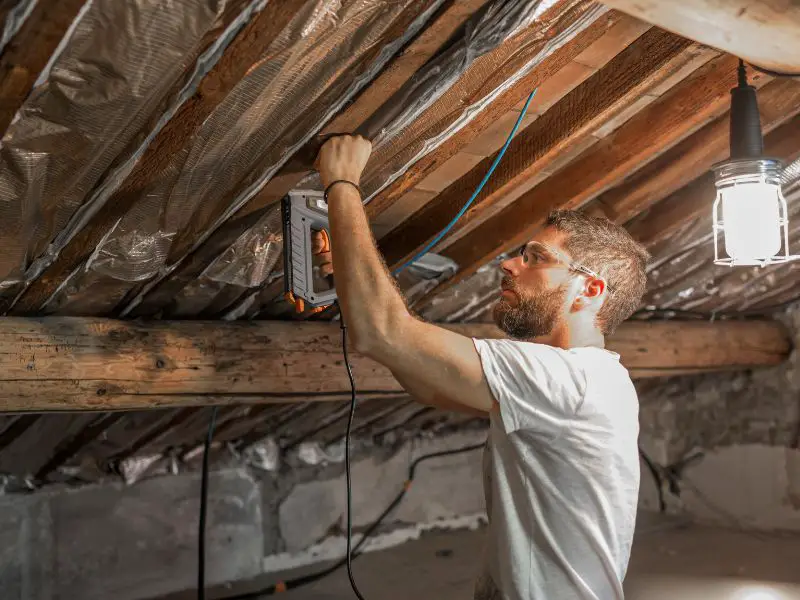Under President Biden’s Administration, the new energy efficiency upgrades could collectively save U.S. homeowners $1.9 billion annually on their energy bills.
That may seem insurmountable, but with the right approach, energy efficiency is achievable.
In this post, we’ll explore simple things you can do to make your home more efficient.

What Is Energy Conservation?
Energy conservation is the process where energy is used and managed more wisely. The main goal of energy conservation is to reduce the number of energy resources used. This usually means reducing the energy wasted in homes by replacing short-circuited electronics or turning off appliances when not in use. Energy conservation is good for the environment because less energy is wasted, so fewer greenhouse gas emissions are created. This helps reduce your carbon footprint from energy use, which is essential in this day and age.
Benefits of Energy Efficiency
According to the U.S. Department of Energy, energy efficiency is the quickest way to save money. The average American family could save $2200 annually on utilities by upgrading their home’s energy efficiency.
Here are some benefits of energy efficiency:
1. Cost Savings
Switching to energy-efficient appliances saves a lot of money in the long run. Appliances that consume more energy cost more to run in the long run and can result in higher utility bills. In 2020 alone, Energy Star reports their energy-efficient products saved consumers more than $520 billion on electric bills.
The Energy Star is a United States Government program that helps consumers save money and energy. The average American household spends $2,200 a year on electricity, heating, and cooling their homes. By switching to energy-efficient appliances, you can expect savings of up to $550 yearly.
2. Environmental Benefits
Because typical power plants use fossil fuels, which contribute to air pollution and generate greenhouse gases, one of the essential things that can be done to combat climate change is to reduce energy consumption. Homes and buildings with greater energy efficiency are also better positioned to transition to renewable energy sources, which do not emit harmful emissions.
3. Resilience and Reliability
Improvements to energy efficiency lower the load or the amount of electricity on the grid. This makes the electric grid less crowded and stressed. Less load keeps the power from going out.
4. Health Benefits
Reduced use of fossil fuels results in cleaner air, water, and land, which directly impacts human health—particularly in marginalized areas and persons suffering from conditions worsened by pollution.
Some Opportunities to Improve Local Energy Efficiency
- Local Government Facilities: The facilities that local governments provide can significantly impact energy consumption. Everything from public transportation to recreational facilities to waste management can be connected to a comprehensive plan to reduce energy consumption. They can achieve substantial energy cost savings by implementing energy-efficient technology and investing in renewable energy.
- Water and Wastewater Facilities: Water treatment plants and other wastewater facilities are major energy consumers. By installing efficient equipment and improving operations and maintenance practices, water and wastewater facilities can realize significant energy savings that translate to savings for their taxpayers and communities. Not only give more savings but reductions greenhouse gasses and other pollutants associated with energy production and use.
- Nongovernment buildings: Providing solutions to increase the energy efficiency of commercial, industrial, and other non-governmental buildings enables local governments to reap far higher advantages than focusing just on their facilities.
- Residential: Local governments may lower energy consumption, help households save money, enhance comfort, and cut greenhouse gas emissions by providing education on how homeowners can improve their energy efficiency in their houses.

Trusted Ways to Make Your Home More Energy Efficient
1. Upgrade Your Windows
Upgrading your windows to energy-efficient ones is a great way to save money and do your part to help the environment. Energy-efficient windows use unique materials that prevent heat from escaping during winter and trap cool air during summer, which can help lower your energy bills. You can also reduce the number of air pollutants in your home, which is a bonus.
The most effective insulation for windows is argon gas, which is placed in the space between the panes of glass. Look for ones that have low emissivity glass coatings. The cost of this can range up to $600 and $700 for each window, but save about 50% on your monthly energy expenditures.
2. Install Energy-Efficient Lightbulbs
Switching to energy-efficient lightbulbs is one of the easiest ways to reduce energy consumption and carbon footprint. Replacing incandescent bulbs with compact fluorescent bulbs (CFLs) and light-emitting diodes (LEDs) can reduce your electricity bill by as much as 75 percent. It’s easy to make the switch, and CFLs and LEDs last up to 10 times longer, so you won’t have to buy bulbs more often. These bulbs are also more efficient and use less energy to produce the same amount of light as an incandescent bulb.
3. Invest in a Tankless Water Heater
Water heating accounts for 14% of an average home’s energy usage. If everyone upgraded their water heater to a tankless one, they would save money on energy bills, and it’s also more durable than conventional storage water. Tankless water heaters use 24% less energy than those with a tank.
For even better outcomes, choose a condensing tankless water heater. These water heaters use exhaust gas to speed up the process of heating your water.
4. Upgrade Your HVAC Systems
As HVAC systems make up as much as 50% of a home’s energy use, upgrading to new, more energy-efficient models is a great way to reduce household energy costs. Modern HVAC systems are far more energy-efficient than older models and use less electricity to run. Replacing aging HVAC systems with modern equipment is one of the easiest ways to save hundreds on your utility bills each year while reducing your carbon footprint.
5. Purchase Energy-Efficient Appliances
When replacing appliances in your house, choose those with a high Energy Star rating. When shopping for a new device, consider the design as well. A front-loading washing machine, for example, not only dries clothing faster (thus lowering the dryer’s workload), but it also consumes less water. To optimize air circulation, your refrigerator, for example, should have roughly an inch of room on both sides. And at least once a year, switch off the fridge and clean the cooling coil of dust and dirt.
6. Improve Your Homes Insulation
Insulation is one of the most essential elements to consider when improving your home’s energy efficiency. If your home is poorly insulated, you’ll probably find that you are constantly experiencing a chill during the winter and that your home is unbearably hot during the summer. Not only can insulation help regulate the temperature of your home, but it can also help to scale down your overall heating and cooling bill.

Author’s Note
Saving energy in your house (and hence saving money) requires considering both the large picture and your daily routines. Analyze your home’s weak points to prioritize your planned energy-efficiency upgrades.
You don’t have to make all of these improvements in a year; instead, plan ahead of time and include innovative energy solutions in your home renovation plans.
Related: Most Sustainable Furniture Manufacturing Companies, How to Start an Indoor Vegetable Garden, Overview of Container Homes, Designing a Permaculture Garden

